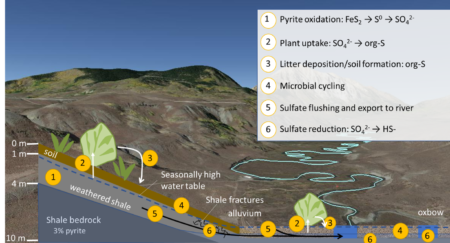
Diagram showing key sulfur cycling processes in the Colorado East River watershed. Image courtesy of Patricia Fox.
The Science
Climate change is expected to increase the release of sulfur from rocks – the largest pool of sulfur on earth – into rivers and lakes, which could lead to deteriorating water quality. Researchers identified the major forms of sulfur in different parts of a pristine mountainous watershed, including in rocks, soils, and sediments near rivers. Biological conversion of sulfur to organic forms in shallow soils and sediments were found to serve as a limited sink for newly released sulfur, meaning this biological transformation would store, or ‘hold onto’, the element. In near-river sediments, however, sulfur was converted to the mineral mackinawite, which does not dissolve in water. These near-river sediments may hold more sulfur as earth’s climate changes. This process could partially offset the increased sulfur released from rocks and lower the risk of sulfur contamination in freshwater.
The Impact
Sulfur is a naturally occurring element which is abundant on earth and stored primarily in rocks. However, research has shown that climate change may be resulting in high amounts of sulfur in freshwater systems; warmer temperatures may increase weathering, or rock deterioration, which releases sulfur in the process, and water cycle changes may lead to less water available to dilute the element. This study used a holistic approach to better understand how sulfur moves between rocks, soils and water in an undisturbed ecosystem. A highly sensitive method, called x-ray absorption spectroscopy, provided new information on how sulfur is released from rocks in addition to the exact chemical forms of sulfur found in rocks, soils, and in the sediments next to rivers. This research allows for a deeper understanding of sulfur cycling that can help to make better predictions of water quality and watershed responses to climate change.
Summary
Sulfur is an important component of the earth’s crust, and its cycling has critical impacts on water quality and human health. Weathering of pyrite, an abundant mineral containing sulfur, is the primary pathway by which sulfur enters surface waters. Although biological cycling of sulfur in watershed ecosystems ultimately mediates the release of sulfur to rivers and the ocean, climate change has led to water cycle alterations that may enhance pyrite weathering rates and therefore the amount of sulfur released from these minerals. In this study, the researchers identified the major forms of sulfur across a pristine mountainous watershed, including shale bedrock, hillslope soils, and near-river sediments using a highly sensitive technique called x-ray absorption spectroscopy. When shale weathering occurred, pyrite was transformed into sulfate, with large accumulations of elemental sulfur. Close to the river, the researchers observed precipitation of mackinawite, another mineral containing sulfur, in water-saturated sediments. By contrast, shallow, unsaturated soil and sediment contained primarily organic sulfur compounds. The whole-watershed approach, combined with a highly-sensitive analytical technique, shows that riverine sulfur exports are controlled by a balance of rock weathering and biological cycling, where sulfur retention in saturated sediments may partially offset the increased release of sulfur from rocks.
Citation
Fox, P. M., et al. Sulfur Biogeochemical Cycling and Redox Dynamics in a Shale-Dominated Mountainous Watershed. Journal of Geophysical Research: Biogeosciences 127, e2021JG006769 (2022). [DOI: 10.1029/2021JG006769]
